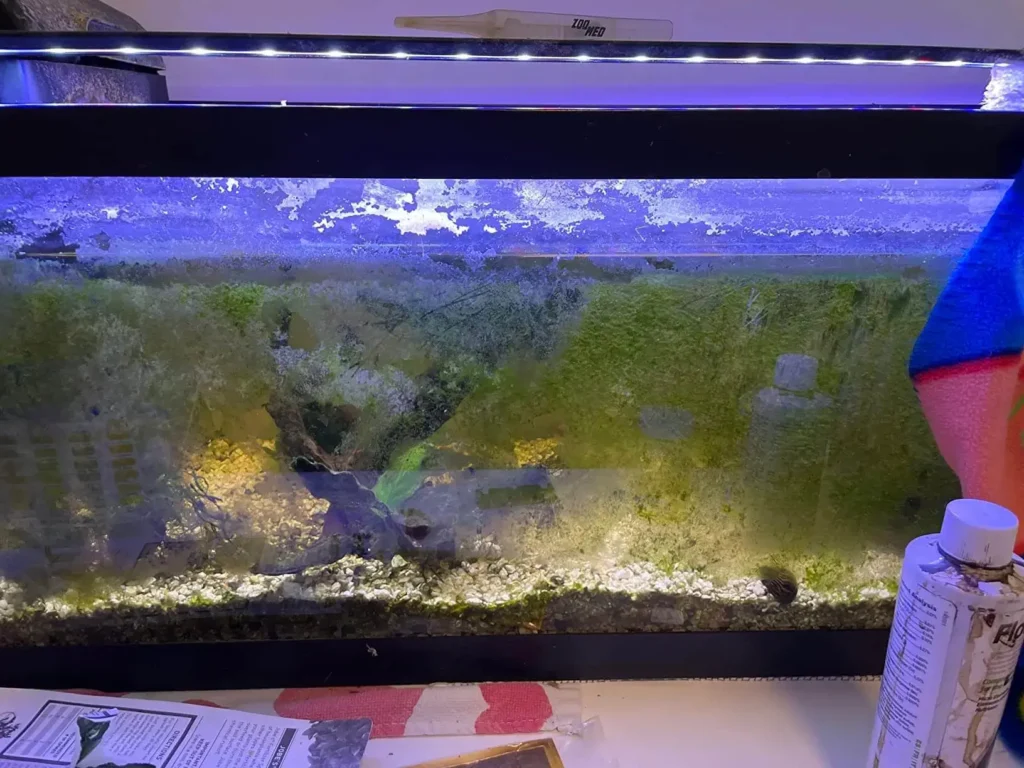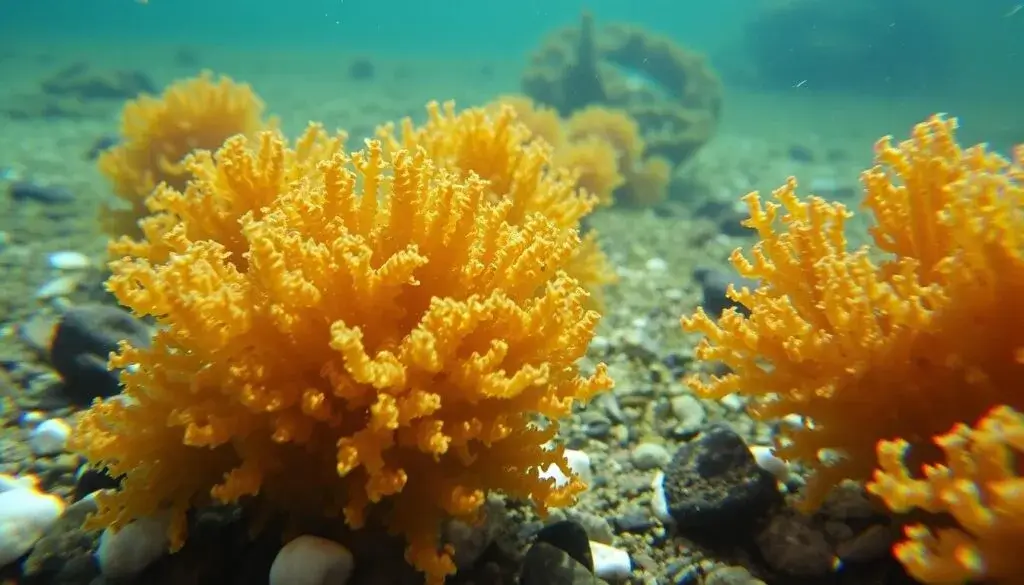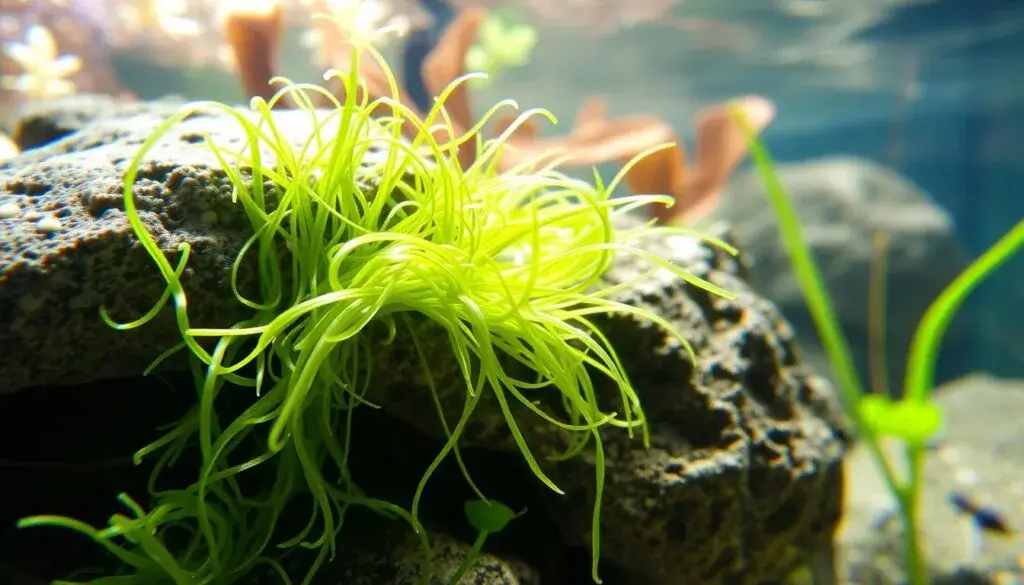Aquarium lovers often face the problem of algae in their tanks. Green water and black beard algae can upset the tank’s balance. This guide will cover common algae types, their causes, and how to deal with them.

Table of Contents
Knowing about algae is key for any aquarium owner. It helps keep your tank healthy and beautiful. We’ll look at algae types, their effects, and how to control them.
Understanding Aquarium Algae Types and Their Impact
Aquarium fans often see different algae types. Each has its own traits and affects the aquarium’s balance. Knowing why algae grows and its role is key to a healthy tank.
Common Causes of Algae Growth
Many things can make algae grow too much. Too much light, bad feeding, poor filters, and changing temperatures are some. Also, too many nutrients like nitrates and phosphates can cause it.
The Role of Algae in Aquarium Ecosystems
Algae help by breaking down bad stuff like ammonia. But too much algae can mess up the tank. It can make water cloudy, lower oxygen, and harm plants.
When Algae Becomes Problematic
Too much algae is a big issue. It happens when care is off, water quality is bad, or nutrients are out of balance. This lets some algae types take over.
| Algae Type | Causes | Indicators |
|---|---|---|
| Green Spot Algae | Phosphate deficiency in plants | Green spots on glass, leaves, or decorations |
| Blue-Green Algae (Cyanobacteria) | Deteriorating plants, excess organic waste, poor oxygen levels, low nitrates | Slimy, mat-like growth on substrate, plants, or glass |
| Green Dust Algae | High nitrate levels, insufficient plant mass, biologically immature tanks, warm temperatures | Fine, powdery green coating on glass or decor |
Knowing why algae grows, its role, and when it’s a problem helps. Aquarium fans can then tackle algae issues. This keeps their tanks healthy and balanced.
Black Beard Algae (BBA): Identification and Treatment
Black beard algae, also known as black brush algae or BBA, is a common problem in aquariums. It can quickly take over and upset the balance of your tank. It’s important to know how to spot BBA and treat it to keep your tank healthy.
Black beard algae thrives on rough surfaces and weak water flow, especially when CO2 levels are unstable. It also loves high levels of nitrates, phosphates, and minerals like potassium and magnesium. This makes it hard to get rid of in tanks that aren’t well-maintained.
If you see dark, soft patches on your plants, driftwood, or tank surfaces, you might have BBA. This algae can spread fast and harm your plants, upsetting the balance of your tank.
- Removing BBA by hand is often the first step. Gently scrub or cut off the affected areas to avoid spreading it.
- Fixing issues like unstable CO2 levels, too much light, and nutrient imbalances is key to stopping BBA from coming back.
- Adding algae-eating fish or snails like Siamese Algae Eaters, Amano Shrimp, or Nerite Snails can help control BBA by eating it.
For tough cases, you might need to use chemicals like hydrogen peroxide, liquid carbon solutions, or a diluted bleach dip. Always follow the instructions and watch your tank closely when using these treatments.
By spotting BBA early and treating it well, you can keep your aquarium healthy and balanced. Stay alert and prevent BBA from becoming a long-term problem in your tank.
Green Water Algae: Causes and Solutions
Green water algae are tiny, single-celled organisms. They can quickly multiply, making your aquarium water look murky and green. These algae thrive in environments with too many nutrients or too much light.
Prevention Strategies
To stop green water algae, you need to tackle the main causes. Don’t let direct sunlight hit your tank, as it can make algae grow faster. Keeping the right levels of nutrients, like phosphates and nitrates, is also important. Regular water tests and changes help manage these nutrients.
Treatment Methods
If algae have already taken over, try the “blackout” method. Cover your tank with something dark, like a blanket or cardboard, for a few days. This blocks light and kills the algae, helping your tank recover.
Using UV Sterilizers
UV sterilizers are also great for fighting algae. They use UV light to harm algae and other small organisms, stopping them from multiplying. Adding a UV sterilizer can make your water clear and keep your aquarium healthy.
“Keeping your aquarium’s water quality and lighting conditions balanced is the best defense against persistent green water algae issues.”
Brown Algae (Diatoms) Management
Brown algae, also known as diatoms, are common in new aquariums. They feed on silicates, nitrates, and phosphorus, creating a slimy film. While they don’t harm fish, they can be a problem in reef tanks and planted aquariums. They compete for nutrients and block sunlight.
High silica levels in the water often cause brown algae. This can come from silica-rich tap water or substrates like silica sand. Too many nitrates from uneaten food or overstocking also lead to diatom blooms. Keeping water chemistry balanced is key to controlling brown algae.
Poor lighting also contributes to brown algae growth. Aquariums in dark places are more likely to have diatom issues. Changing the lighting and improving oxygen levels can help manage brown algae.
- Regularly change some of the water to remove excess nitrates and silicates.
- Use a gravel vacuum to clean diatoms from the substrate during water changes.
- Adding algae-eating fish like Yellow Tangs, Otocinclus Catfish, or Plecostomus can help control algae.
- Carefully clean decorations, fake plants, or rocks to remove diatom buildup.
By tackling the causes of brown algae and taking proactive steps, you can manage diatom growth. This helps keep your aquarium healthy and balanced.

“The presence of brown algae can indicate that the water chemistry in the aquarium is not balanced.”
Blue-Green Algae: The Cyanobacteria Challenge
In the aquarium world, blue-green algae, also known as cyanobacteria, can be a big problem. These photosynthetic organisms can quickly cover surfaces, making them look bad and smell bad. They grow well in places with lots of organic waste, too much light, or poor water flow.
Identifying Blue-Green Algae
Blue-green algae can look different, from single cells to thick mats. They often look like a slimy, blue-green mat or a strong-smelling scum on the water’s surface or decorations. Knowing how to spot cyanobacteria is key to controlling their growth and keeping your aquarium healthy.
Treatment Options
- Introduce fast-growing plants: Adding robust, oxygen-producing plants can help outcompete and suppress the growth of blue-green algae.
- Use Excel or Maracyn treatments: Certain aquarium-safe chemicals, such as Excel or Maracyn, can be effective in controlling cyanobacteria outbreaks.
- Implement the blackout technique: Completely covering the aquarium for several days can starve the cyanobacteria of light, causing them to die off.
Prevention Tips
- Maintain proper water quality: Ensure good water circulation, adequate filtration, and regular water changes to reduce organic waste and nutrients that fuel cyanobacteria growth.
- Control lighting: Avoid excessive or inconsistent lighting, as blue-green algae thrive in well-lit environments.
- Introduce algae-eating fish: Species like Ancistrus, Otocinclus, and Crossocheilus can help manage cyanobacteria populations.
By understanding blue-green algae and using treatments and prevention strategies, you can keep your aquarium healthy. This way, you can avoid the problems caused by this tough type of algae.
Hair and Thread Algae Control
Hair algae and thread algae are common in both freshwater and saltwater aquariums. They thrive in tanks with high ammonia or on damaged plant leaves. It’s important to control their growth to keep your aquarium healthy and vibrant.
Regular manual removal is a key method to fight these algae. Trimming affected plants and removing algae can stop their spread. It’s crucial to do this often, as they can grow fast, sometimes several inches in days.
Keeping water parameters right is also vital. Regular water changes help control nitrate and phosphate levels, starving algae. Also, the right lighting levels are important, as too much light can fuel their growth.
Some fish, like plecostomus, mollies, and Amano shrimp, can help control algae. But their effectiveness depends on their size and age. The best way to manage hair and thread algae is through consistent tank maintenance and a proactive approach.
| Algae Type | Identification | Control Methods |
|---|---|---|
| Hair Algae | Forms long, hair-like strands that can grow several inches quickly |
|
| Thread Algae | Thin, thread-like algae that can grow on plant leaves and hardscape |
|
By focusing on tank maintenance, removing algae, and keeping water conditions right, you can control hair and thread algae. A proactive approach is key to a healthy, balanced aquarium.

Essential Prevention Strategies for All Aquarium Algae Types
To keep your aquarium healthy and free of algae, you need to act early. Focus on water quality, lighting, and nutrient balance. This will help stop different algae types from growing in your tank.
Water Quality Management
Changing 10% to 15% of the water each week is key. It helps dilute and remove nutrients like phosphates and nitrates that algae love. Using chemicals to remove phosphates can also help. Plus, keeping water temperature and pH steady makes it harder for algae to grow.
Lighting Considerations
Good lighting is vital to stop algae problems. The right amount and type of light helps plants grow and keeps algae in check. Adding live plants to your tank can also help. They soak up extra nutrients and compete with algae for food.
Nutrient Balance
Keeping nutrients balanced is crucial to stop algae. Too much food for your fish means too many nutrients for algae. Make sure CO2, nitrates, phosphates, and other nutrients are at the right levels. This helps your fish and plants thrive and keeps algae away.
By following these prevention tips, you can manage and control algae in your tank. This will keep your aquarium looking great and healthy.
Natural Algae Control Methods
Keeping your aquarium algae-free doesn’t need harsh chemicals or hard cleaning. Natural methods are effective and good for the environment. Adding algae-eating fish and invertebrates is a great way to start.
Some top algae-eating fish include the Ancistrus (bristlenose plecos), Otocinclus affinis (dwarf suckermouth catfish), and Hypostomus punctatus (common pleco). Also, Crossocheilus siamensis (Siamese algae eater) and Gyrinocheilus aymonieri (Chinese algae eater) are great. These fish eat different algae types, helping keep your tank balanced.
Snails are also good at controlling algae. Ramshorn snails, for example, eat green, brown, and red algae. They can reach places that cleaning tools can’t, making them a natural solution.
Using these natural methods can make your aquarium healthier and more beautiful. It also means less use of harsh chemicals or hard cleaning. Finding the right balance of algae-eating species is key to a healthy tank.
“Incorporating natural algae control methods into your aquarium maintenance routine can create a healthier, more balanced ecosystem.”
Choosing the Right Algae Eaters
Choosing the right algae eaters is key to keeping your aquarium clean. You can pick from fish, invertebrates, or a mix. It’s important to pick ones that fit your tank’s needs and the other fish and creatures in it.
Fish Species
Some top fish for fighting algae are Bristlenose Catfish, Chinese Algae Eaters, and Siamese Algae Eaters. Bristlenose Catfish grow up to 5 inches and need tanks of at least 25 gallons. Chinese and Siamese Algae Eaters can get up to 6 inches and do well in tanks of 25 to 30 gallons. They like a pH of 6.5 to 7.0 and temperatures of 75 to 79 degrees.
Invertebrates
Snails and shrimp are also great at eating algae. Trumpet Snails, Mystery Snails, Nerite Snails, and Ramshorn Snails love to eat different types of algae. Cherry Shrimp and Amano Shrimp are good choices too. They can live in smaller tanks and help control algae.
Compatibility Considerations
It’s important to make sure the algae eaters you choose get along with your other fish and creatures. Think about their size, how they act, and what they eat. Also, make sure your tank can provide what they need. They might have different needs than your other fish and invertebrates.